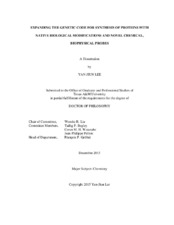| dc.description.abstract | Engineering of protein with new modifications essentially expands the protein functions which provide powerful tools for investigating significant biological questions. New modifications also offer scientists the ability to handle protein activity at will. Therefore, development of facile and robust protein modification protocol is highly desirable in almost every aspect of biological research. In combination with chemistry and biology principles, the genetic code expansion technology has emerged as an effective strategy for manipulating proteins and interrogating biological systems. In this regard, the overall objective of the presented research is to expand the chemical biology toolbox based on noncanonical amino acid incorporation and bioorthogonal chemistry.
During my graduate study, I was focused on methodology development to genetically incorporate defined, homogeneous native protein posttranslational modifications and new chemical/biophysical probes into proteins for biological investigations, particularly for epigenetic applications. I have established the protocol to incorporate various native lysine acylations into proteins including crotonylation, propionylation and butyrylation. In addition, I also developed a chemical biology approach to study epigenetics, coined “chemical antibody”. This approach allows high throughput fluorescent detection of posttranslational modifications without the use of antibodies. I genetically encoded native lysine posttranslational modification surrogates, such as acryloyllysine, into proteins. Coupled with the bioorthogonal chemistry development, the site-specific detection of the posttranslational modifications was accomplished, essentially offering an alternative route for understanding epigenetic enzyme network. Following the same line of approach, in order to study protein long chain fatty acid acylation, I incorporated long chain unstrained alkene into proteins as chemical reports that are able to be selectively labeled via tetrazine-based bioorthogonal reaction. This development also generates a new direction of research in studying the long chain fatty acid metabolic acylome using chemical biology approach. Lastly, the site-specific incorporation of fluorine-containing noncanonical amino acid probes into proteins was also developed. Fluorine is referred to as “magic bullet” in medicinal organic chemistry and biochemistry. Introducing fluorine into protein allows generating an unrivalled unique probe in a protein without any structural perturbation. The site-specific incorporation of perfluorinated probes is an invaluable tool for the study of noncovalent protein interactions as well as the application on protein designs.
Overall, the collective work presented has extensively improved our ability of handling site-specific protein modifications with native biological PTMs and handy chemical/ biophysical probes for diverse medical and biological applications. | en |


